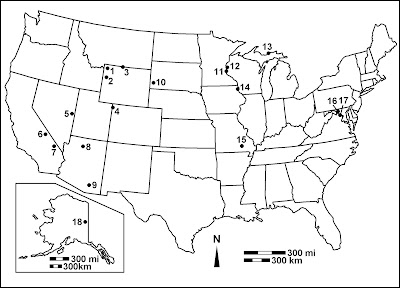Like Club Late Ordovician, membership in the League of Saint Croix is for those NPS units with fossils of late Cambrian age. "Late Cambrian" requires a bit of clarification. Cambrian stratigraphic divisions are a bit unsettled. The current stand-in for the Upper/Late Cambrian (remember, "upper" with rocks, "late" with age), the Furongian Stage, is almost but not quite the same as the traditional Upper/Late Cambrian. It encompasses a bit less, and at any rate is not called the Upper or Late Cambrian. The base of the traditional Upper/Late Cambrian is apparently at about the base of the Linguagnostis reconditus trilobite zone, which is approximately the base of the North American Crepicephalus trilobite zone (Peng et al. 2012). Therefore, for our purposes "late Cambrian" is Crepicephalus up to the Ordovician, a couple million years less than 15 million years with current dates. These qualifications net us 18 parks:
A quick scan of the fossils reported from these 18 parks shows that times were tough all over. It's definitely a time of brachiopods, trilobites, and trace fossil producers. Trilobites were reported at 15 of the 18, and brachiopods at 11. The supporting cast is a mix of hyoliths, snails and snail-like mollusks, conodonts, echinoderms, and more enigmatic invertebrates. I have not gone into details for most of these units like I have for St. Croix National Scenic Riverway, but it appears that the best represented parks are St. Croix NSR, Death Valley NP, Great Basin NP, Yellowstone NP, and Yukon-Charley National Preserve. Upper Cambrian species have been named from seven of them; no points for guessing that most of the taxa are trilobites.
Geographically, the units are pretty well spread out. They trace a "swoosh" from southeastern Arizona into the Mojave and Great Basin, then to the Yellowstone region, the Black Hills, the Upper Midwest, and finally to the Potomac. Granted, this is due in large part to the distribution of parks, but it is certainly true that the Mojave, Great Basin, Yellowstone, and Upper Midwest are well-represented in the Cambrian in general.
Some of these Croixan parks are also noted for their older Cambrian fossils, perhaps the most famous being Death Valley, Grand Canyon, and Yellowstone. In fact, in the same publication in which Charles Walcott introduced the "St. Croixan" (Walcott 1912), he also introduced the Waucoban for the early Cambrian, from the Waucoba Springs area now in northwestern Death Valley NP. The Cambrian of Grand Canyon NP is best known from the Tapeats–Bright Angel–Muav sequence (McKee and Resser 1945), older than the Croixan. Death Valley, Grand Canyon, St. Croix NSR, and Yellowstone are linked historically by Walcott's interest in Cambrian life.
Ozark National Scenic Riverways has an interesting parallel with St. Croix NSR. In both areas, there is the development of a zone of boulder conglomerate on pre-Cambrian igneous bedrock before the seas fully established themselves (see Bridge 1930 for more on the Ozark geology). We've seen this in the Mill Street Conglomerate of the Taylors Falls/St. Croix Falls area. There is also an unusually rich monoplacophoran fauna in the Ozark area, although the setting appears to have been within stromatolite reefs rather than among boulders (Stinchcomb 1975).
 |
| Bonus diagram! This is a schematic representation of the Cambrian trilobite zones in the St. Croix Valley, with N (roughly Taylors Falls/St. Croix Falls) on the left and S (roughly Afton) on the right. You can tell it's schematic because I didn't try to work in the Precambrian basement. (Actually, you can more or less ignore the Mount Simon, which as I noted last week is hardly ever encountered in the area). The propensity for zones to "rise" going north is clear, as well as the absence of good faunas in most of the Jordan. The base data comes from a number of stratigraphic sections, compiled mostly in Nelson (1949), Berg (1951, 1954), Berg et al. (1956), and Runkel et al. (2007). |
References
Berg, R. R. 1951. The Franconia Formation of Minnesota and Wisconsin. Dissertation. University of Minnesota, Minneapolis, Minnesota.
Berg, R. R. 1954. Franconia formation of Minnesota and Wisconsin. Geological Society of America Bulletin 65(9):857-881.
Berg, R. R., C. A. Nelson, and W. C. Bell. 1956. Upper Cambrian rocks in southeast Minnesota. Pages 1–23 in R. Sloan and G. M. Schwartz, editors. Lower Paleozoic geology of the Upper Mississippi Valley. Geological Society of America, New York, New York. Guidebook Series Field Trip 2.
Bridge, J. 1930 (1931). Geology of the Eminence and Cardareva quadrangles. Missouri Bureau of Geology and Mines, Rolla, Missouri. Report 24, 2nd series.
McKee, E. D., and C. Resser. 1945. Cambrian history of the Grand Canyon region. Carnegie Institution of Washington Publication 563.
Nelson, C. A. 1949. Cambrian stratigraphy of the St. Croix Valley. Dissertation. University of Minnesota, Minneapolis, Minnesota.
Peng, S.-C., L. E. Babcock, and R. A. Cooper. 2012. The Cambrian Period. Pages 437–488 in F. M. Gradstein, J. G. Ogg, M. Schmitz, and G. Ogg, coordinators. The geologic time scale 2012. Elsevier, Amsterdam, Netherlands.
Runkel, A. C., J. F. Miller, R. M. McKay, A. R. Palmer, and J. F. Taylor. 2007. High-resolution sequence stratigraphy of lower Paleozoic sheet sandstones in central North America: the role of special conditions of cratonic interiors in development of stratal architecture. Geological Society of American Bulletin 119(7–8):860–881. Online supplemental material available.
Stinchcomb, B. L. 1975. Paleoecology of two new species of Late Cambrian Hypseloconus (Monoplacophora) from Missouri. Journal of Paleontology 49:416–421.
Walcott, C. D. 1912b. Cambrian geology and paleontology II. No. 10.—Group terms for the Lower and Upper Cambrian series of formations. Smithsonian Miscellaneous Collection 57(10):304–306. Available at: http://biodiversitylibrary.org/page/9263457.

No comments:
Post a Comment